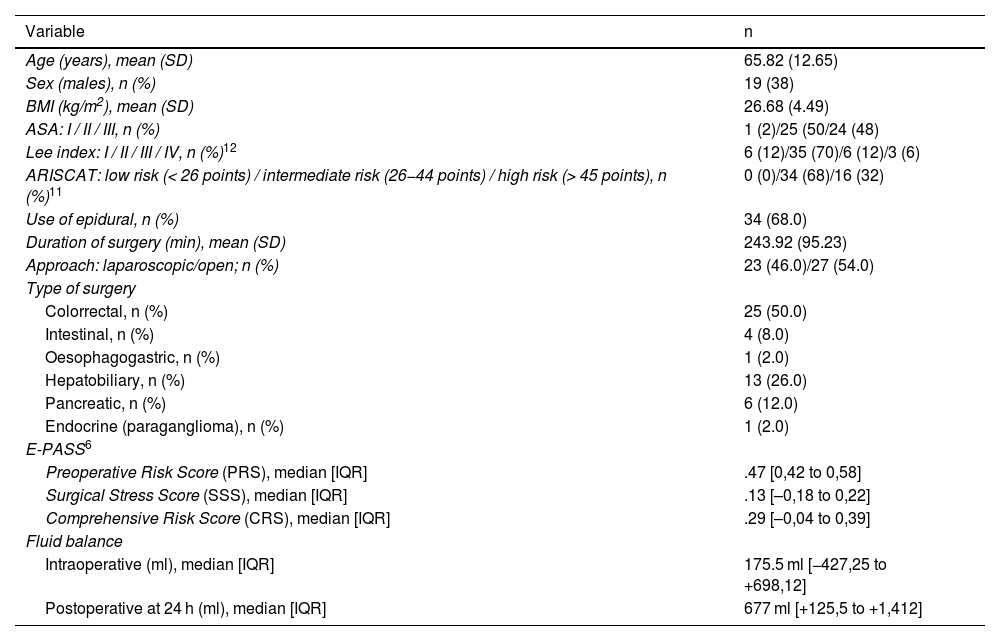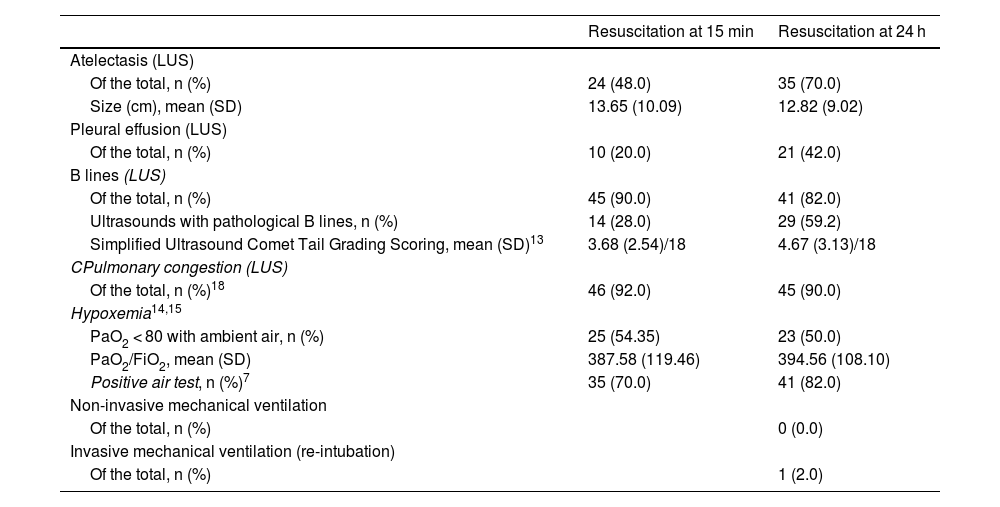The harmful effects of excess fluids frequently manifest in the lungs. Thoracic fluid content (TFC) is a variable provided by the STARLINGTM bioreactance monitor, which represents the total volume of fluid in the chest. The objective is to analyse the association between the variation in TFC values (TFCd0%) at 24 h postoperatively, postoperative fluid balance, and postoperative pulmonary complications.
Material and methodsProspective and analytical observational study. Patients scheduled for major abdominal surgery at a tertiary teaching hospital were included. They were monitored during the intervention and the first 24 postoperative hours with the monitor. STARLINGTM, measuring TFC and its variation in different stages of the perioperative period. Serial lung ultrasounds were performed and postoperative pulmonary complications were recorded. Logistic regression was performed to predict the occurrence of atelectasis and pulmonary congestion. The Pearson correlation coefficient was calculated to verify the association between TFC and fluid balance.
Results50 patients were analyzed. TFCd0% measured on the morning of the first postoperative day increased by a median of 27.1% [IQR: 20.3–37.5] and was correlated at r = 0.44 with the postoperative balance of 677 ml [IQR: 125.5−1,412]. Increased TFC was related to a higher risk of atelectasis (OR = 1.24) and pulmonary congestion (OR = 1.3).
ConclusionsTFCd0% measured 24 h after surgery presents a moderate correlation with postoperative fluid balance. Its increase is a risk factor for the appearance of postoperative pulmonary complications.
Los efectos nocivos del exceso de líquidos se manifiestan frecuentemente en los pulmones. El TFC (Thoracic Fluid Content) es una variable que proporciona el monitor por biorreactancia STARLING™, que representa el volumen total de líquido en el tórax. El objetivo es analizar la asociación entre la variación de los valores del TFC (TFCd0%) a las 24 horas postoperatorias, el balance hídrico postoperatorio y las complicaciones pulmonares postoperatorias (CPP).
Material y métodosEstudio observacional prospectivo y analítico. Se incluyeron pacientes programados para cirugía abdominal mayor en un hospital universitario de tercer nivel. Fueron monitorizados durante la intervención y las 24 primeras horas postoperatorias con el monitor STARLING™, midiendo el TFC y su variación en distintas etapas del perioperatorio. Se realizaron ecografías pulmonares seriadas y se recogieron las CPP. Se realizó una regresión logística para predecir la aparición de atelectasias y congestión pulmonar. Se calculó el coeficiente de correlación de Pearson para comprobar la asociación entre TFC y balance hídrico.
ResultadosSe analizaron 50 pacientes. El TFCd0% medido en la mañana del primer día postoperatorio aumentó una mediana de un 27,1% [IQR:20,3–37,5] y se correlacionó con una r = 0,44 con el balance postoperatorio de 677 ml [IQR: 125,5–1412]. El aumento del TFC se relacionó con un mayor riesgo de sufrir atelectasias (OR = 1,24) y congestión pulmonar (OR = 1,3).
ConclusionesEl TFCd0% medido a las 24 horas de la cirugía presenta una correlación moderada con el balance hídrico postoperatorio. Su incremento es un factor de riesgo para la aparición de complicaciones pulmonares postoperatorias.












